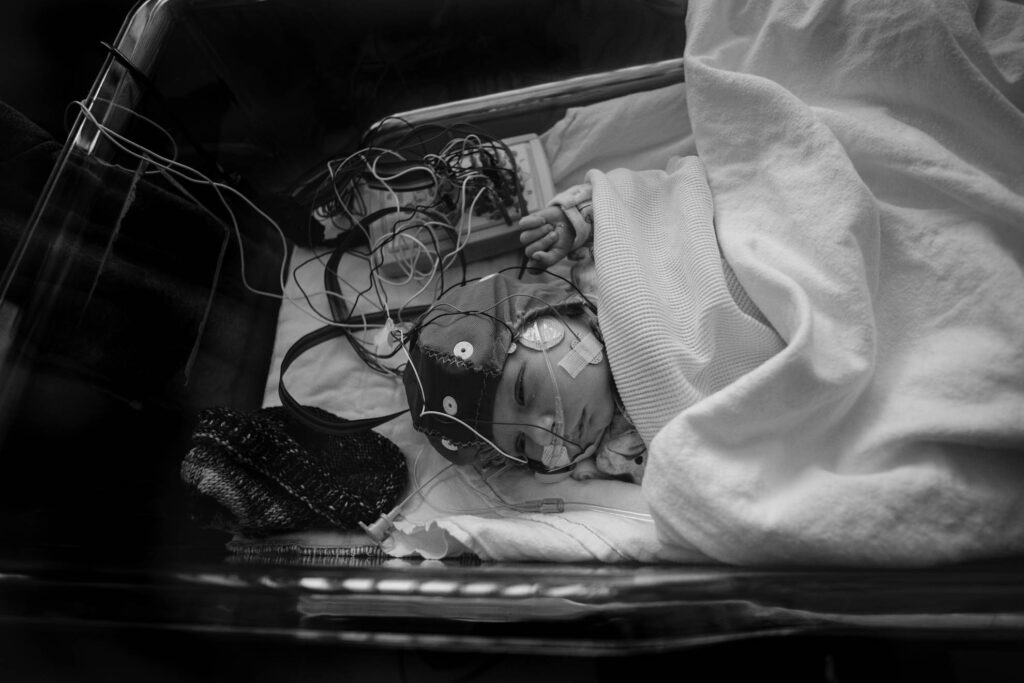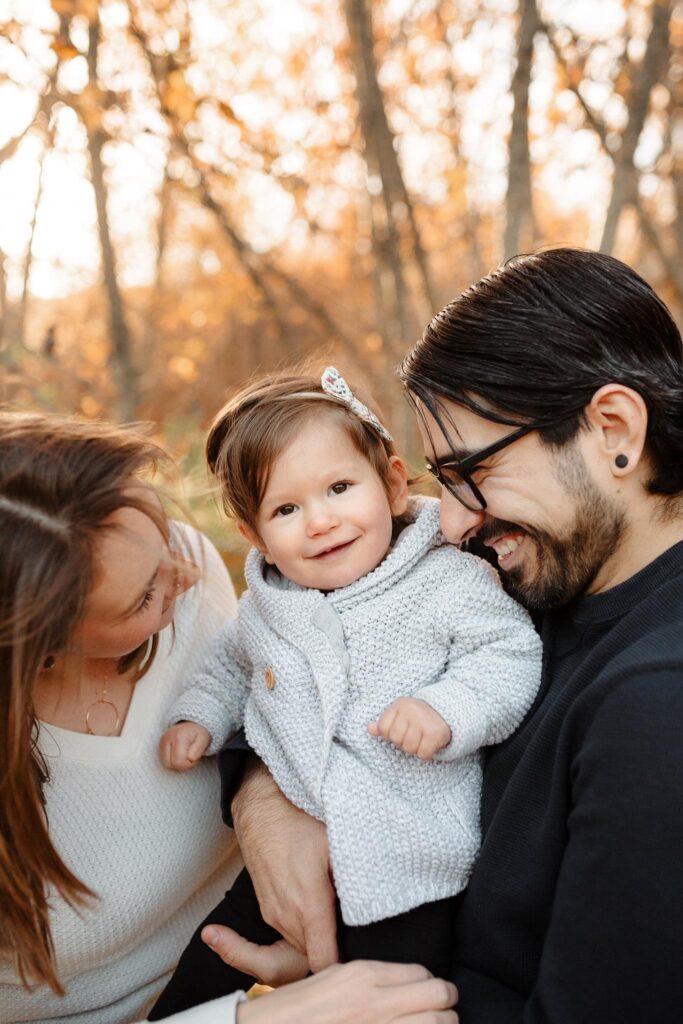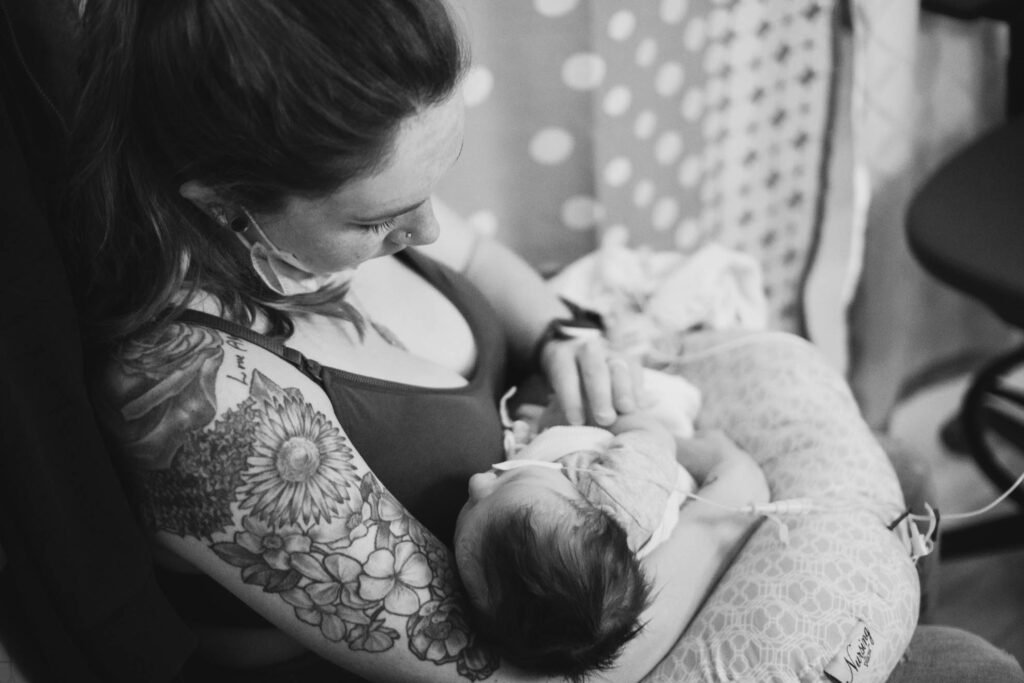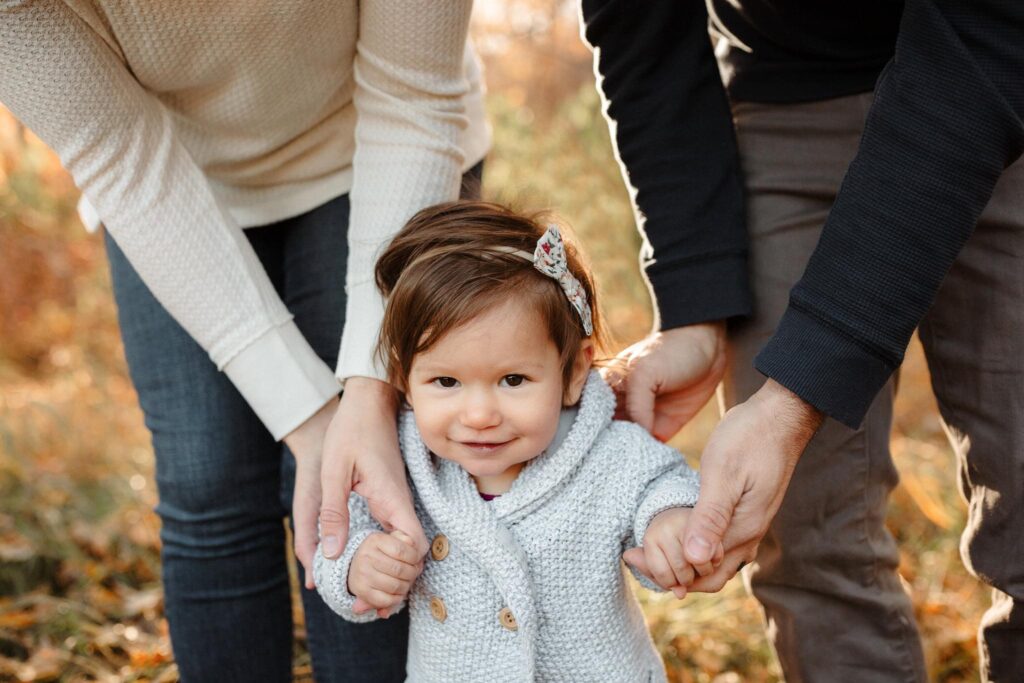
Names: Amanda and Sam Torres
Location: Alberta, Canada
Child’s Birth Year: 2020
Keywords: HIE Dad, New to HIE, PTSD & Mental Health, Supporting Your Partner
Amanda and Sam met in Colorado, eventually getting married in 2017, after moving to Edmonton, Alberta, in Canada. Sam worked as a manager at a climbing gym before the pandemic, while Amanda, a registered social worker, had worked as an addiction counselor with youth experiencing substance use and mental health-related concerns. Through her profession, Amanda had been exposed to the uglies of life, witnessing firsthand just how much adversity children had to endure from such young ages. However, in their life, surrounded by supportive family members and friends, never did Amanda or Sam think that their first child, Ruby, would also deal with so many challenges from the moment she was born in October 2020.
As an overdue Amanda anticipated labor, she felt the weight of uncertainty, a thousand unanswered questions swirling through her mind. Given the constantly changing landscape of COVID-19, which hospitals would even be open for delivery? Would she be allowed to do a waterbirth like she had envisioned? Would Ruby be okay, given that she was in a breech position? Would Amanda go into labor before needing to be induced? The answer to that last question was yes. As Sam and Amanda headed to the hospital, they were ready to have their little baby girl out in this world, with them.
At the hospital, Amanda labored in a birthing pool. For the most part, everything seemed fine, but labor was not moving forward as quickly as anyone anticipated. As time passed, Amanda grew tired, and the water became cold. Shivering, Amanda went to the toilet to try laboring, where she started bleeding. At that point, Amanda was taken to the bed to be checked out, but she still had no concept that anything was wrong.
When Ruby was halfway out, Amanda’s contractions slowly fettered away until she noticed she wasn’t having them anymore. The OB/GYN and midwife encouraged Amanda to “Just push. Keep pushing, Mama.” Amanda remembers pushing like her and Ruby’s lives depended on it, and she was able to get Ruby all the way out, despite feeling no contractions. Such a feat takes an unbelievable amount of strength.
As Ruby was placed on her chest, all the extremes of human emotion flooded over Amanda at once. But, more than anything, Amanda felt unbelievably whole. With her daughter in her arms at last, Amanda felt an overwhelming sense of pure joy and love. As she looked up at Sam, she spoke words she knew to be true: “Nothing else matters.”
In the hospital room, it was as if Amanda’s whole world had rearranged. That day did not just signal the birth of Ruby, but the birth of a mother, the birth of a family, and the birth of a newfound perspective. After Sam cut the umbilical cord, and Ruby was rushed over to a crash cart to be stabilized, Amanda let the gratitude she felt for being Ruby’s mother resonate. Although she was utterly confused about what was going on, not fully understanding why Ruby was being transferred to a hospital with a formal NICU, Amanda ultimately leaned on her faith that the medical team was doing everything in their power to give Ruby the best care possible.
This faith is what Amanda held onto during the emotionally turbulent twenty-three days in the NICU that ensued. In the midst of all the lows—like that heartbreaking drive home from the NICU in a car with an empty car seat, the MRI results that showed notable damage to Ruby’s basal ganglia, and the frustrating times when it felt like there was no end in sight—Amanda and Sam reminded themselves why they continued to show up every day. For Ruby, for the family, for what matters most.
The neonatologist told Amanda and Sam that parents just being present was part of the medicine and part of the healing process. During their NICU stay, they found this to be irrevocably true. Once Amanda and Sam were assigned a private room on the unit and could spend more time with Ruby, they witnessed improvements in her health. And, yet, even then, these improvements were far from linear. There would be some days where Ruby made tremendous progress with breastfeeding, but then, the next day, she couldn’t keep up because she was so exhausted from the day before. In the seemingly ceaseless cycle of two steps forward and one step back, Amanda often felt defeated and overwhelmed. But Ruby’s care team encouraged Amanda to remember that those steps back were a natural part of the process and that each child goes at his/her own pace. The providers were amazing in giving Ruby the time she needed to figure herself out instead of giving up on her.
After three weeks in the NICU, Ruby was finally discharged. The transition home was a huge adjustment. Amanda and Sam were so used to seeing Ruby hooked up to different machines and being monitored 24/7. Suddenly, there was none of that. At the same time, Amanda struggled with trauma, and, in many ways, she is still confused about how she feels toward her body—her body simultaneously kept Ruby alive in utero for months, yet also almost killed Ruby at birth. Luckily, Amanda began to work through some of these issues by seeing a therapist who specializes in birth trauma. Further resources that helped Amanda and Sam cope with the transition home were the great follow-up care Ruby received and the Hope for HIE community. Through Hope for HIE, Amanda became close friends with two fellow HIE moms, who truly understand why Amanda continues to worry about Ruby’s future, even when she appears “fine.”
Now, Amanda has come to understand that there is no expiration date for uncertainty. Just as she experienced during the NICU stay, the healing process is continually evolving and fluctuating. Amanda has moments where she is incredibly amazed by all the progress Ruby has made with early intervention therapy. But there, too, are other moments where she finds herself getting lost in comparison, measuring where Ruby is in relation to those with both “better” and “worse” outcomes. Ultimately, Amanda reminds herself that, just because Ruby may not have the most severe outcome, that does not negate the challenges and trauma their family has endured. She also circles back to what Ruby’s neonatologist told her on MRI day—we need to let Ruby move at her own pace.
In this life of HIE, spirituality has served as Amanda’s anchor amidst a sea of constant flux. Throughout Amanda’s educational journey, she was privileged to learn from Indigenous elders, who shared that children are “little spirits” who come into this world, intentionally choosing their families because they have something to teach them. Amanda holds onto this philosophy as a driver of hope. In those moments where she falls into a spiral, thinking this isn’t how it was supposed to be, Amanda remembers that Ruby is here for a purpose. When Amanda thinks about how she’d thought she was “supposed” to hold Ruby on her chest, breastfeed her, bring her home, and that everything would be lovely, she remembers that Ruby is gifting them, here to teach them something they may not have previously known, and this outlook has made Amanda even more grateful for Ruby and more hopeful for their HIE journey than she could have ever imagined.
Ruby has already taught Amanda and Sam so much. She has taught them both what it means to love fiercely. Ruby has shown Amanda just how resilient she actually is, both mentally and physically. Ruby has realigned their worldview, making Amanda and Sam more aware of issues, such as access to healthcare and ableism. Ruby has impacted their lives in so many amazing ways, and Amanda and Sam view their roles as parents to be that of making sure Ruby reaches her full potential. Not the potential of the neighbor’s kid, or the potential of another child with HIE, but her unique potential.
When Ruby is having a difficult time in physio or during tummy time, or when they are just having a bad day, Amanda falls back on a motto that “as a family, we can do hard things.” As a family, they have so much to be proud of. Amanda is proud of unapologetically advocating on Ruby’s behalf with medical providers, as well as all the work she has put into addressing her trauma. Ruby needs Amanda to be at her best, and only by taking care of herself and being honest about what she can and cannot handle will Amanda get there.
Amanda and Sam are also proud of remaining there for each other as a couple, in spite of all of the stress of this past year. Married life is never perfect, but, at the end of the day, they both show grace for each other. This HIE journey has really shown them that it takes a village to get through all of this. A village may not necessarily mean having dozens of family and friends to reach out to for support, but it may mean having that one person you can lean on during the good days and the bad days.
Even though the NICU experience was difficult, Amanda and Sam are so grateful for all the support they received along the way. The nurses were unbelievably kind and took care of Amanda and Sam, just as much as they took care of Ruby. Friends and family members were quick to help out, by taking care of the dogs and providing meals so that Amanda and Sam didn’t have to stress over all the logistical issues of being away from home. Oftentimes, friends and family can feel lost, not knowing the best way to support HIE parents during such a terrifying situation. Amanda and Sam want to emphasize that, even the seemingly small things make a world of difference, whether it’s dropping off a meal or paying for the parents’ hospital parking.
Perhaps, though, what this experience has opened their eyes to the most is how irrevocably thankful they are for Canada’s social policies. In their HIE journey, where there were already so many other things they had to worry about, Amanda and Sam never had to worry about the cost of treatment for Ruby or having to argue with insurance companies for hours on end. Amanda was able to get a one-year maternity leave with employment insurance, and Sam’s work essentially told him to take as much time away as he needed. They acknowledge the privilege they have experienced in not having some of the same burdens as many other HIE parents. In the future, they hope to share their unique perspectives of having lived both in the United States and Canada to continue to advocate for increased access to healthcare.
Since Ruby’s birth in 2020, Amanda and Sam’s whole world has shifted drastically. They have experienced more pain than they ever thought possible, but they have also experienced more love and joy than they had ever previously known. They know that they might have some challenges down the road that are harder to navigate, but with their village behind them—through the connections they have forged with those in the HIE community, the kindness of friends, family, and coworkers, and the support they have bestowed upon one another—they can do hard things. And no matter what Ruby’s outcomes will look like, Ruby chose them to be her parents, so they will continue to choose her right back and love her fiercely, each and every day.




Connect with families, read inspiring stories, and get helpful resources delivered right to your inbox.